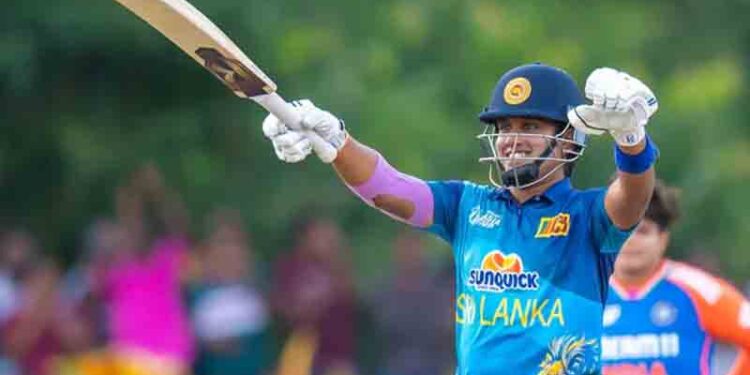In a stunning and historic turn of events, the Sri Lankan Women’s Cricket Team has finally broken their long-standing losing streak against India by securing a remarkable three-wicket win in the Women’s One-Day Tri-Series. The match, held at the iconic A. Premadasa Stadium in Colombo, will be remembered as a turning point for Sri Lankan women’s cricket, as they defeated the much stronger and higher-ranked Indian side for the first time in over seven years.
A Long-Awaited Triumph for Sri Lanka
The victory marked Sri Lanka’s first ODI win over India since September 2018, a testament to their growth and resilience as a team. Over the years, India has dominated the head-to-head contests, often winning by large margins, and had established a psychological edge over their South Asian neighbors. However, the tide turned dramatically in the fourth match of the tri-nation series that also involves Bangladesh.
India’s Strong Batting Performance Sets High Target
India, batting first after winning the toss, posted an imposing total of 275 runs for the loss of 9 wickets in their allotted 50 overs. The pitch at the A. Premadasa Stadium offered little assistance to the bowlers early on, and the Indian batters took full advantage.
Richa Ghosh Leads the Charge
The highlight of India’s innings was the explosive batting display by wicketkeeper-batter Richa Ghosh, who scored a quickfire 58 runs off just 48 balls. Her innings included five boundaries and three towering sixes, showcasing her aggressive intent and ability to accelerate the scoring rate.
Middle-Order Contributions Add Stability
Apart from Ghosh, Jemimah Rodrigues made a valuable 37 runs, while all-rounder Pratika Rawal chipped in with a composed 35. Indian skipper Harmanpreet Kaur also contributed 30 runs, providing a solid platform in the middle overs. However, the Indian team failed to capitalize on their starts, and frequent wickets towards the end prevented them from reaching the 300-run mark.
Sri Lanka’s Gritty Run Chase Stuns India
Chasing a daunting total of 276, Sri Lanka’s women showed exceptional determination and nerves of steel. Their run chase was marked by smart shot selection, timely boundaries, and aggressive intent, particularly in the middle and death overs.
Nilekshi Siloha’s Match-Winning Knock
Middle-order batter Nilekshi Siloha emerged as the star of the match with a sensational 56-run knock off just 33 balls. Her innings, which included five fours and three sixes, came at a crucial time when Sri Lanka needed to increase the scoring rate. Siloha’s confident stroke play and ability to find the gaps kept the scoreboard ticking and lifted the spirits of the home side.
Solid Start by Harshitha Samaraweera
Opener Harshitha Samaraweera provided a solid foundation at the top of the order with her well-paced 53 runs off 51 balls. Her calm and composed batting in the powerplay overs allowed her team to build momentum. Samaraweera’s innings featured several elegant strokes through the covers and demonstrated excellent shot timing.
Crucial Lower-Order Contributions
Apart from the star performers, contributions from other Sri Lankan batters, including Hasini Perera and Nilakshi de Silva, were vital in steering the team home. The match saw several momentum shifts, but Sri Lanka held their nerve and managed to reach the target with five balls to spare, ending the match at 276 for 7.
A Moment of National Pride for Sri Lanka
The win sparked celebrations among fans and players alike. Social media platforms lit up with messages congratulating the Sri Lankan women’s team on their exceptional performance. Cricket analysts hailed the victory as a significant step forward for women’s cricket in Sri Lanka, which has often been overshadowed by the men’s game.
Sri Lanka’s head coach and support staff praised the team’s fighting spirit, calling the win a reward for the months of hard work and discipline during training camps and practice matches.
India Reflects on Missed Opportunities
While the Indian team started the match as favorites, their inability to defend a large total raised questions about their bowling strategy and field placements in the final overs. Several dropped catches and fielding errors also contributed to their downfall.
India’s head coach acknowledged Sri Lanka’s superior performance on the day and emphasized the need for introspection, especially with the ICC Women’s Championship and upcoming international series in mind.
Background: India’s Dominance in Women’s Cricket
India has been a powerhouse in women’s cricket, with players like Mithali Raj, Harmanpreet Kaur, Smriti Mandhana, and Jhulan Goswami dominating the international circuit for years. Their dominance over Sri Lanka has been near-complete, especially in ODIs, where the Indian side regularly posted large totals and bowled out the opposition with ease.
Before this game, India had won 11 consecutive ODI matches against Sri Lanka. The last time Sri Lanka beat India was during a home series in September 2018. That match was also a close affair, which Sri Lanka won by three wickets.
Significance of the Tri-Series
The ongoing Women’s One-Day Tri-Series is part of a broader initiative by the International Cricket Council (ICC) to increase the visibility and competitiveness of women’s cricket in the subcontinent. The tri-series format not only gives emerging teams more match experience but also helps them prepare for global events like the Women’s Cricket World Cup and the ICC Women’s T20 World Cup.
For Sri Lanka, this victory is not just about ending a seven-year drought against India; it is about setting the tone for the future. The confidence gained from defeating a cricketing giant will likely inspire more young women to take up the sport professionally in Sri Lanka.
What’s Next for Both Teams?
Following this result, both India and Sri Lanka will play the remaining matches in the tri-series with renewed strategies. For India, the focus will likely shift to strengthening their bowling attack and improving fielding standards. For Sri Lanka, the key will be to maintain consistency and build on this momentum.
The final of the series is expected to draw significant attention, particularly if these two teams face each other again in a rematch. It will be interesting to see how India responds to this defeat and whether Sri Lanka can continue their winning form.
Conclusion: A Turning Point for Women’s Cricket in South Asia
Sri Lanka’s victory over India in the Women’s One-Day Tri-Series is more than just a historic win; it is a testament to the progress of women’s cricket in the region. It reflects the narrowing gap between traditional powerhouses and emerging teams and serves as an inspiration for aspiring cricketers across the continent.
As the competition intensifies and more such matches grab the spotlight, women’s cricket in South Asia stands on the cusp of a new era—one of equal recognition, thrilling rivalries, and growing fan support.

























